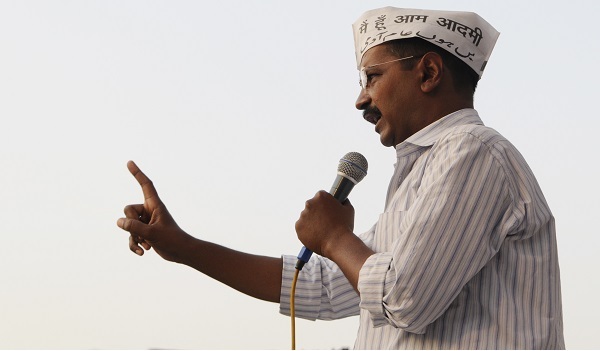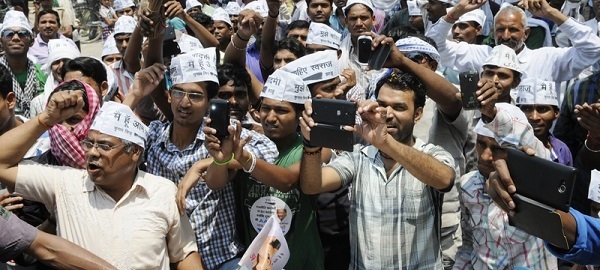
 Data Structure
Data Structure Networking
Networking RDBMS
RDBMS Operating System
Operating System Java
Java MS Excel
MS Excel iOS
iOS HTML
HTML CSS
CSS Android
Android Python
Python C Programming
C Programming C++
C++ C#
C# MongoDB
MongoDB MySQL
MySQL Javascript
Javascript PHP
PHP
- Selected Reading
- UPSC IAS Exams Notes
- Developer's Best Practices
- Questions and Answers
- Effective Resume Writing
- HR Interview Questions
- Computer Glossary
- Who is Who
What is the full form of AAP ?
Introduction
AAP stands for Aam Aadmi Party. The party grew from an anti-corruption movement conducted across India to pressurise the government to pass the Jan Lokpal Bill. Currently, the party has been re-elected as the ruling government in New Delhi and its leader Mr. Arvind Kejriwal is the current Chief Minister of Delhi government. The party's political history and their modes of campaign since its birth has helped Arvind Kejriwal to successfully build a specific image of him. He is also recognized as the ?Mufflerman' who was mostly seen as a ?anti-corruption crusader' clad in a ?muffler'. Through this article we will briefly discuss the party.

Mr. Arvind Kejriwal, leader of AAP, giving a speech.
Reasons for the formation of AAP
The reasons for the formation of the AAP can be traced to a decade long movement conducted for the passing of the Jan Lokpal Bill in the Indian Parliament. The movement for the passing of the Jan Lokpal Bill was a civil society movement against corruption which started in April, 2011. Activists from various backgrounds organised this movement in 2011 under a common banner named ?India Against Corruption'. This occurred when the nation could no longer tolerate the big-ticket scam scandals that came into light during the rule of the Congress led UPA regime.
This movement under the leadership of Anna Hazare, continued for two years. It spread through various cities and towns of India and witnessed the mobilisation of lakhs of people under the context of rising against corruption. Protestors also sat on fast as a mode of protest with the aim of pressuring the then Congress government to pass the Jan Lokpal Bill. Despite the massive protest and conducting of fast for three times, when the government did not agree to pass the Jan Lokpal Bill, some people from the IAC movement started the process of forming Aam Aadmi Party under the headship of Arvind Kejriwal.
Political History of AAP
AAP was formed on October 2nd, 2012 under the leadership of Arwind Kejriwal. According to AAP, they are a party for the common people of the country with no entry restrictions. People of all age, race, religion, language, gender, economic status can join the organisation. The party's financial expenses including fundraising for electoral activities are mostly crowd-sourced.
The first election that the party contested was the Delhi Assembly Election of 2013, the very election that made Arvind Kejriwal the Chief Minister of Delhi in 2013. The party won 28 seats out of 70. It defeated former Chief Minister Sheila Dikshit and hence swept the Congress off the majority. According to the party, their approach to this win was different from other major political parties. They claim to have adopted a ?issue-based campaign' without utilising the strategies of religion and caste based politics.
After the party formed its government in Delhi, they failed to pass the Jan Lokpal Bill. This reason forced them to resign in 2014, February subsequent to which they also lost the 2014 Delhi Lok Sabha Elections. Next year, the 2015 Delhi Assembly shocked the territory when AAP won the elections with a majority of seats i.e, 67 out of 70. They had conducted massive campaigns for the 2015 election. Their clarion call was ?Paanch Saal Kejriwal'.

A rally by supporters of AAP
Organisation of the party
The party is organised into 5 different levels with subdivisions under them. At the Primary Level there are Primary Units at the Ward level and Municipal level and also at the college or university level. The Block Council operates at the Block Level and provides coordination among all Primary Level. The party also has District level Council and Executives beside having State level Council and Executive. They also have a National Council and Executive which are an important structure of the Party.
Objectives of the AAP
Since, AAP is a party that is formed out of the anti-corruption movement, their first and foremost objective has always been to provide an alternative politics to the citizens of the country which will not only be free from corruption but also remain accountable to the people of the country. Some of their objectives are
They aim for transparent funding mainly on the basis of crow-sourcing.
They aim to transform the healthcare, education system, and provide free water.
They also work towards rejecting the VIP culture by rejecting the use of red beacon cars.
They also reject ?dynastic politics' in the sense that they do not allow two members of a family to contest election or hold a position of power in the party.
Conclusion
The AAP was born from an anti-corruption movement in India. It is a party which claims itself to be the people-centric party whose main motive is to reduce or end corruption. It tries to provide the people of India with alternative politics which is different from other majority political parties in the country.
FAQs
Q1. Describe an issue which was part of the AAP's issue-based electoral campaign in 2013.
Ans. One issue of their campaign was the water and electricity bills of Delhi and hence the name of the campaign as ?Bijli Paani Andolan'. Kejriwal and his team not only protested against the high electricity and water bill but also against the Congress government's cooperation with their companies. As a mode of protest he also sat on fast since March 23rd for fourteen days besides conducting a signature campaign against the raising bills.
Q2. State one of the objectives of AAP.
Ans. AAP aims to preserve India's culture and heritage. They believe in treating every citizen as equal in front of the government and also abide by the Constitution of India.
Q3. What are the functions of the National Council of the AAP?
Ans. The National Council of the AAP is the most important body of the party which has the responsibility of making the policies. Due to this reason the council consists of eminent experts from various fields of the country.

